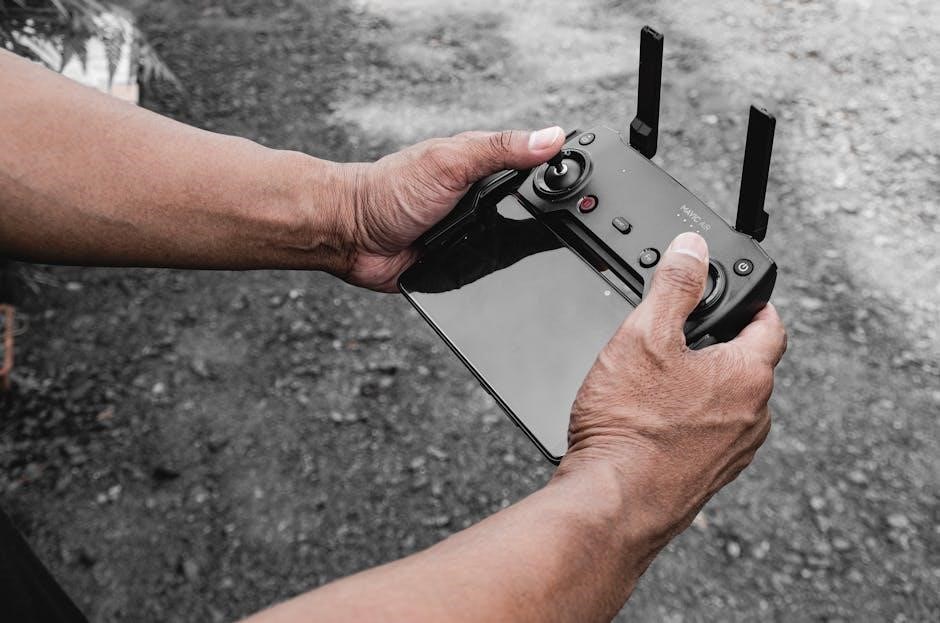The Waters Acquity UPLC System is a cutting-edge chromatography platform designed for high-performance separations. It combines innovative UPLC technology with advanced features to deliver superior resolution, speed, and sensitivity. This system is widely used in laboratories for analyzing complex samples in pharmaceutical, biotechnological, and environmental applications. Its integrated design ensures seamless operation, while its robust construction guarantees long-term reliability. The Acquity UPLC system is a cornerstone in modern analytical chemistry, enabling precise and efficient sample analysis.
1.1. Overview of UPLC Technology
Ultra-Performance Liquid Chromatography (UPLC) is a revolutionary analytical technique that represents a significant advancement over traditional High-Performance Liquid Chromatography (HPLC). UPLC technology, pioneered by Waters Corporation, is designed to deliver superior separation efficiency, faster analysis times, and higher sensitivity compared to conventional HPLC methods. The core of UPLC lies in its use of sub-2 micron chromatographic particles, which enable higher resolution and faster separations without compromising efficiency.
The Waters Acquity UPLC system leverages this technology to provide unparalleled performance in laboratories. By operating at higher pressures (up to 15,000 psi), UPLC systems can achieve rapid solvent flow rates and shorter column lengths while maintaining excellent chromatographic performance. This results in significantly reduced analysis times, often by a factor of 5-10 compared to traditional HPLC, making it ideal for high-throughput laboratories.
UPLC technology also enhances sensitivity and selectivity, enabling the detection of trace analytes in complex matrices. This is particularly beneficial in pharmaceutical, biopharmaceutical, and environmental analysis, where the ability to separate and quantify components in challenging samples is critical. Additionally, the smaller particle size used in UPLC columns reduces solvent consumption, contributing to cost savings and environmental sustainability.
The Waters Acquity UPLC system integrates seamlessly with advanced detection technologies, such as photodiode array (PDA), fluorescence, and mass spectrometry, further expanding its analytical capabilities. This integration ensures that users can maximize the potential of UPLC technology in their workflows, whether for method development, routine analysis, or regulatory compliance.

1.2. Key Features and Benefits

The Waters Acquity UPLC system is distinguished by its innovative design and advanced features, which deliver exceptional performance for modern chromatographic analysis. One of its key features is the quaternary solvent manager, enabling the creation of complex gradients with precision and accuracy. This capability is particularly useful for separating intricate mixtures and optimizing method development. Additionally, the system incorporates a high-pressure pumping system, capable of operating at pressures up to 15,000 psi, ensuring rapid and efficient separations.
Another notable feature is the integrated column heater, which allows for precise temperature control during analysis. This feature enhances method reproducibility and enables the optimization of separation conditions for a wide range of applications. The Acquity UPLC system also includes a sample manager with a flow-through needle design, minimizing carryover and ensuring accurate sample injection. This design is particularly beneficial for high-throughput laboratories where sample integrity is paramount.
The system is further complemented by a range of detection options, including UV-Vis, fluorescence, and mass spectrometry. The Waters ACQUITY QDa mass detector, for instance, provides robust and reliable mass analysis, making it an ideal choice for laboratories requiring high sensitivity and selectivity. These detection capabilities, combined with the system’s advanced chromatographic performance, enable users to tackle complex analytical challenges with confidence.
One of the most significant benefits of the Acquity UPLC system is its ability to reduce analysis time while maintaining or improving separation efficiency. By leveraging UPLC technology, laboratories can achieve faster results without compromising data quality, leading to increased productivity. Furthermore, the system’s compact design and energy-efficient operation contribute to lower operational costs and environmental impact.
The Waters Acquity UPLC system also offers seamless integration with Waters’ software solutions, such as Empower and UNIFI, enabling streamlined data acquisition, processing, and reporting. This integration enhances workflow efficiency and facilitates compliance with regulatory requirements. Overall, the Acquity UPLC system’s combination of advanced features, high performance, and user-friendly design makes it an indispensable tool for modern analytical laboratories.

Key Components of the Acquity UPLC System

The Acquity UPLC system comprises several essential components designed to optimize chromatographic performance. The solvent manager delivers precise gradient control, while the sample manager ensures accurate injection. A column heater maintains consistent temperatures for reliable separations. Detectors, such as UV-Vis or mass spectrometry options, provide sensitive detection. The system also includes a solvent tray for efficient solvent handling. Together, these components integrate seamlessly, enabling high-speed, high-resolution separations with minimal downtime, making the Acquity UPLC system a versatile tool for advanced analytical workflows.

2.1. Solvent Manager
The Solvent Manager is a critical component of the Waters Acquity UPLC system, responsible for delivering precise solvent gradients and maintaining consistent flow rates during chromatographic separations. Equipped with advanced pump technology, it ensures high-pressure performance, enabling the use of small particle size columns for superior resolution. The Solvent Manager supports up to four different solvents, allowing for flexible and complex gradient profiles. Its design minimizes delay volume, reducing re-equilibration times and improving overall system efficiency.
One of the standout features of the Solvent Manager is its ability to operate at pressures up to 15,000 psi, making it suitable for the demanding conditions of UPLC. The system also incorporates automated solvent degassing, which prevents gas bubbles from forming and interfering with the analysis. This feature enhances reliability and reduces downtime. Additionally, the Solvent Manager is equipped with a solvent tray that can hold multiple solvent bottles, ensuring continuous operation without interruption.
The Solvent Manager is designed for seamless integration with other components of the Acquity UPLC system, such as the Sample Manager and detectors. Its intuitive control software allows users to program solvent gradients, monitor system performance, and troubleshoot issues in real-time. The system also supports method scouting and optimization, enabling users to fine-tune their separations for optimal results. With its robust construction and advanced features, the Solvent Manager plays a pivotal role in delivering the high-speed, high-resolution separations that the Acquity UPLC system is known for.

Regular maintenance of the Solvent Manager is essential to ensure optimal performance. This includes flushing the system with solvent after use, replacing seals and pistons as needed, and performing calibration checks. The Waters Acquity UPLC manual provides detailed guidelines for maintenance and troubleshooting, helping users maintain the system in peak condition. By combining precision, reliability, and ease of use, the Solvent Manager is a key enabler of the Acquity UPLC system’s capabilities in modern analytical chemistry.

2.2. Sample Manager
The Sample Manager is a vital component of the Waters Acquity UPLC system, designed to streamline sample preparation and injection processes. It offers precise control over sample handling, ensuring accurate and reproducible results. The Sample Manager supports both manual and automated sample injection, catering to laboratories with varying throughput needs. Its advanced design minimizes carryover and ensures consistent sample delivery, making it ideal for high-throughput and sensitive analyses.

One of the key features of the Sample Manager is its flow-through needle design, which eliminates the need for syringe-based injection. This design reduces maintenance and enhances reliability, as there are fewer moving parts prone to wear and tear. The Sample Manager also incorporates a cooled sample compartment, allowing for precise temperature control of samples during storage and injection. This feature is particularly useful for analyzing thermally sensitive compounds.

The Sample Manager is fully integrated with the rest of the Acquity UPLC system, enabling seamless communication and operation. Users can control the Sample Manager through intuitive software, programming parameters such as injection volume, sample tray temperature, and wash solvent settings. This integration ensures that the entire system operates in harmony, delivering high-speed and high-resolution separations.
Regular maintenance of the Sample Manager is crucial to maintaining optimal performance. This includes cleaning the injection needle, replacing seals, and ensuring proper alignment of the sample tray. The Waters Acquity UPLC manual provides detailed maintenance schedules and troubleshooting guidelines to help users keep the Sample Manager in peak condition. By combining precision, automation, and ease of use, the Sample Manager enhances the overall capabilities of the Acquity UPLC system, making it a powerful tool for modern chromatography applications.






























































